Sometimes it is sunny, other times it rains, and at times it can get sticky hot out there. Weather is constantly changing minute to minute. For the most part, these changes are the result of changes in air pressure. Air pressure is a measure of all the molecules in the air that make up the atmosphere. When air pressure is lower cooling and cloud formation tends to happen. Which also increases the chances of rain. When air pressure is high it pushes air molecules to the ground, and this prevents clouds from forming. The worksheets found in this section work on the very basic direction in which weather moves after I is formed. You will find a wide variety of worksheets that show you how to understand forecast images and how they came to be.
Print Weather Worksheets
Click the buttons to print each worksheet and associated answer key.

Types of Precipitation
Precipitation comes in many forms. These maps use various symbols to represent different types of precipitation.

Wind Speeds and Directions
This series of maps use various symbols to represent wind directions and speeds as shown in the legend below. Using the map below, provide the wind directions and speeds in the cities listed in the table below the map.

Symbols on Maps
Maps like the one below provide data that meteorologists use to prepare forecasts. To accurately read a climate map you must recognize the symbols and what they represent.

Complete the Map
Use the map shown to complete the chart below indicating weather conditions in several US cities

Understanding Precipitation
Precipitation is what we call water that condenses and falls to earth in one of several forms depending on the conditions in the atmosphere. Below on the left are the names of various types of precipitation and the symbols used for them.

Weather Systems and Prediction
Atmospheric conditions are constantly changing, you will make four copies of this page to see how. For three days use a new sheet each day to copy that day's weather pattern (precipitation, frontal systems, and pressure cells) from your newspaper.

Relative Humidity
The amount of water vapor that the atmosphere can hold at a specific temperature is called the relative humidity and is measured with a hygrometer.
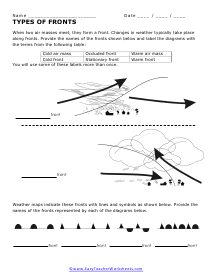
Types of Fronts
When two air masses meet, they form a front. Changes in weather typically take place along fronts.

Cold Fronts
The diagram below shows a front forming between two air masses. At ground level, the colder air mass replaces the warmer air mass.

Warm Fronts
The diagram below shows a front forming between two air masses. At ground level, the warmer air mass replaces the cooler air mass.

Types of Clouds
The diagram below shows examples of many types of clouds. Provide labels for each of these using the terms from the following table.

Clouds and Their Relation to Weather
Specific kinds of conditions are associated with different types of clouds. The mostly blank chart below shows four different kinds of clouds.

Comparing Forecasts to Weather
Forecasts are not always accurate and you will see how accurate the ones for your area are. Fill in the chart below with the forecasts and actual data on each day for a week.

Measuring Weather
Meteorologists use several different types of instruments to gather atmospheric data. Provide the names of instruments that meteorologists use to gather data by using the terms.


Weather Crossword
Example clue: Sound made by rapidly heating and expanding air caused by lightning.

The Biggest Forces of Nature and the Damage They Cause Passage
Nature can be powerful and deadly causing mass destruction and loss of life. Some of the worst storms on record to date are hurricanes, tornadoes, and tsunamis.

Biggest Forces of Nature Multiple Choice Questions
What were the estimated damages of Hurricane Katrina?
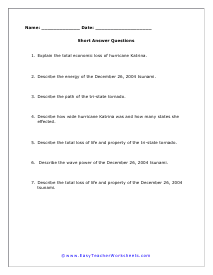
Biggest Forces of Nature Short Answer Questions
Describe how wide hurricane Katrina was and how many states she effected.

How Does Air Pressure Relate to Weather?
Air pressure is a term used to describe air molecules, which are tiny invisible particles of air. In between all the tiny invisible air particles are empty spaces.

How Does Air Pressure Relate to Weather? Multiple Choice Questions
. What is the special tool used to measure air pressure?

How Does Air Pressure Relate to Weather? Short Answer Questions
What precautions do coastal resident take during periods of low pressure?

What should I do in a Lightning Storm?
If you see a storm cloud brewing, hear distant thunder, or see far off lightning, you will know a storm is coming. Always remember, any time you hear thunder, you will know there is lightning in the storm because lightning produces thunder.

What should I do in a Lightning Storm? Short Answer Questions
Describe the effects of electricity on someone’s body when lightning is about to strike.


What is Morning Dew or Morning Frost?
When the air gets full and can hold no more moisture, 100% relative humidity is reached. At 100% relative humidity, the invisible water vapor will become visible. When the water vapor becomes visible, you will see steam, clouds, or fog.

Morning Dew or Morning Frost Multiple Choice Questions
Which of the following is not an example of visible water vapor?

Morning Dew or Morning Frost Short Answer Questions
Describe what happens when water vapors become visible.
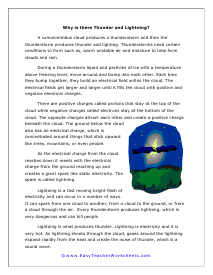
Why is there Thunder and Lightning?
A cumulonimbus cloud produces a thunderstorm and then the thunderstorm produces thunder and lighting.

Why is there Thunder and Lightning? Multiple Choice Questions
Which of the following is not needed by a thunderstorm?

Why is there Thunder and Lightning? Short Answer Questions
Explain what happens when liquid and ice particles bump together.

Why is Thunder Loud?
Thunderstorms produce lightning, which is a very hot flash of electricity and then lightning produces thunder. As lightning shoots through a thunderstorm cloud, it can reach temperatures between 30,000 to 50,000 degrees, which is hotter than the sun.

Why is Thunder Loud? Multiple Choice Questions
A negative charge moving down in a zigzag pattern is what?

Why is Thunder Loud? Short Answer Questions
Describe the sound of thunder when lightning moves from a cloud to the ground.

What is a Hurricane?
A hurricane is a very large storm that forms over tropical regions of both the Atlantic and Pacific Oceans. Rotating in a counter clockwise motion around a center, called an eye, hurricanes can reach speeds up to 200 miles per hour and measure 600 miles wide.

What is a Hurricane? Multiple Choice Questions
. This scale is used to determine how severe and what kind of damages may be caused by a hurricane.


What is a Tornado?
A tornado is a funnel shaped column of air capable of causing mass destruction. Some people call tornadoes twisters or funnel clouds because of their shape and swirling motion however, a funnel cloud does not become a tornado until it touches the ground.

What is a Tornado? Multiple Choice Questions
This scale is used to determine how severe and what kind of damages may be caused by a tornado.
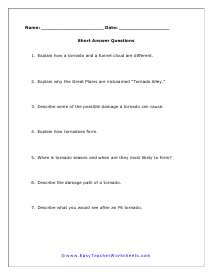
What is a Tornado? Short Answer Questions
When is tornado season and when are they most likely to form?

What is a Tsunami?
As a tsunami gets closer to shore and enters shallower water, it will slow down in speed but will gain height and energy because the top of the wave is moving faster than the bottom at this point.

What is a Tsunami? Multiple Choice Questions
How many nations make up the Pacific Tsunami Warning System?

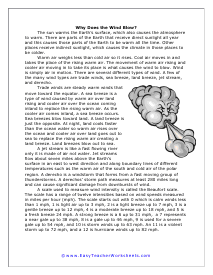
Why Does the Wind Blow?
The sun warms the Earth's surface, which also causes the atmosphere to warm. There are parts of the Earth that receive direct sunlight all year and this causes those parts of the Earth to be warm all the time.

Why Does the Wind Blow? Multiple Choice Questions
How many categories are there for rating wind intensity?

Why Does the Wind Blow? Short Answer Questions
Explain why parts of the Earth are warm all the time and why some are cold.

Destructive Weather
A thunderstorm is a heavy rainstorm that includes lightning, thunder, wind, and occasionally hail. A thunderstorm forms when warm, moist air near the ground moves up into the sky quickly.

Destructive Weather Questions
A tornado is a column of wind that spins very fast. The winds from a tornado can reach as much as three hundred miles per hour.

Precipitation
Precipitation is another word for water that falls from the sky. Water can fall in the form of rain, snow, or ice.

QUESTIONS: Precipitation
Clouds can form in several different ways. What do all the ways have in common?

Meteorology
The study of the Earth's atmosphere, which includes the science of forecasting the weather, is called meteorology.

QUESTIONS: Meteorology
Meteorology is important because it allows for people to minimize loss of life and damage to property by preparing for extreme weather conditions like hurricanes, tornadoes, blizzards, etc.

What Are Clouds?
Clouds can be described according to the elevation at which they form. Clouds that form above 20,000 feet are called high-level clouds.



QUESTIONS: Seasons
At every position relative to the sun, the amount of sunlight that reaches the Earth is slightly different.



The Atmosphere
Most of the exosphere is located in what we consider to be outer space, which is generally considered to begin between 50 and 80 miles from the Earth's surface.


Wind
There are always areas of low pressure at the North and South Poles, because the air there is always cold.


Droughts
Drought can be triggered in different ways. A large amount of reflected sunlight combined with more than the average number of high-pressure systems, winds containing continental as opposed to oceanic air systems, and ridges of high-pressure systems high in the air can all reduce the formation of thunderstorms or rain over a particular area.

QUESTIONS: Droughts
A drought is a naturally-occurring weather event that is characterized by an extended period of less than normal amounts of precipitation.

Fronts
The boundaries between warm and cold air pressure systems are called fronts. This is where most storms originate.

What Causes Weather?
Weather significantly impacts our day-to-day activities. You wouldn’t feel comfortable wearing thin clothes on a snowy morning or walking to work without an umbrella on a rainy day. Hence, keeping yourself in sync with the latest weather updates is essential.
Weather is a combination of many atmospheric factors. This includes temperature and humidity, atmospheric pressure, and wind speed. While weather is specific to a particular locality, they are also affected by the weather in neighboring areas.
We have all experienced weather and its massive effects on our lives. Poor weather can change the way we interact with our environment and it can affect our moods and actions on a daily basis. We look at the forecast to determine how we should dress for our day and what we should do on our day. Extreme conditions can hurt us or in some cases bring us prosperity. Cloud formations can be used to predict what is coming our way. Any form of weather that continues endlessly can change what we do and where we did it. We have many tools available to us to understand climate and its patterns.
How do atmospheric conditions lead to different weather conditions? Is the weather constant, or is it fleeting? If you're curious, the following sections provide answers to these questions.
What Is Weather?
We were taught about the different types of weather in grade school. When the sun shines brightly throughout the day, we say we have a sunny day. When it’s dark and gloomy, it’s a cloudy day. And when it’s pouring hard, we know it’s a rainy day. From these examples, we know that weather is just the short-term condition of the atmosphere.
Unlike climate, weather changes rapidly and is fleeting. Today could be scorching hot, yet it might rain cats and dogs tomorrow. This is why forecasters monitor the weather nonstop throughout the day.
What Factors Cause Weather?
The main elements that describe weather are:
- Temperature
- Humidity
- Atmospheric pressure
- Wind speed and direction
Precipitation, which also counts as an element that describes the weather, is a product of a mix of the previously mentioned factors.
Technically, weather cannot take place without wind. The wind stirs and carries atmospheric components from one place to another. For instance, wind direction dictates where rain clouds end up, and wind speed tells us how soon they reach a specific location.
The sun's heat energy, measured in terms of temperature, has just as much to do with the weather as the wind. It leads to the evaporation of surface waters, causes wind speed changes, and gives meteorologists a clue about when and how much precipitation is expected.
When the humidity is high, the “real feel” temperature becomes higher than its actual value. This is because our sweat evaporates much slower, reducing our body’s capability to cool itself down. Hence, the weather feels hotter.
It is also worth noting that while weather is specific to a particular locality, weather in neighboring areas also affects the weather in your region. For instance, when a storm currently ravages across Canada, neighboring states in the US may expect to experience stormy weather in the next few days.
How Are Weather Forecasts Made?
To predict the weather, forecasters must first describe the current atmospheric conditions.
As such, they keep track of a set of indicators, including the factors mentioned in the previous section, continuously gathered 24 hours a day from weather stations, satellites, and ships scattered worldwide.
The immense amount of data is then inputted into supercomputers found in weather forecasting centers and used as input in complex mathematical models that predict the behavior of a particular weather event.
As the supercomputers continuously churn out predictions, meteorologists use their expertise and experience tracking weather to fine-tune the predictions made by the machine.
Conclusion
Weather is the short-term result of a mix of factors brewing in the atmosphere. Temperature, pressure, and wind speed are among the primary indicators that forecasters look at to predict weather daily.
It is worth noting that weather can change drastically from one day to another, or even in less than 24 hours. Hence, meteorologists work around the clock to distribute timely weather updates.
We should regularly check updated forecasts to avoid getting soaked in the rain, suffering from the scorching heat, or having our properties damaged due to a lack of preparation for the weather ahead.


